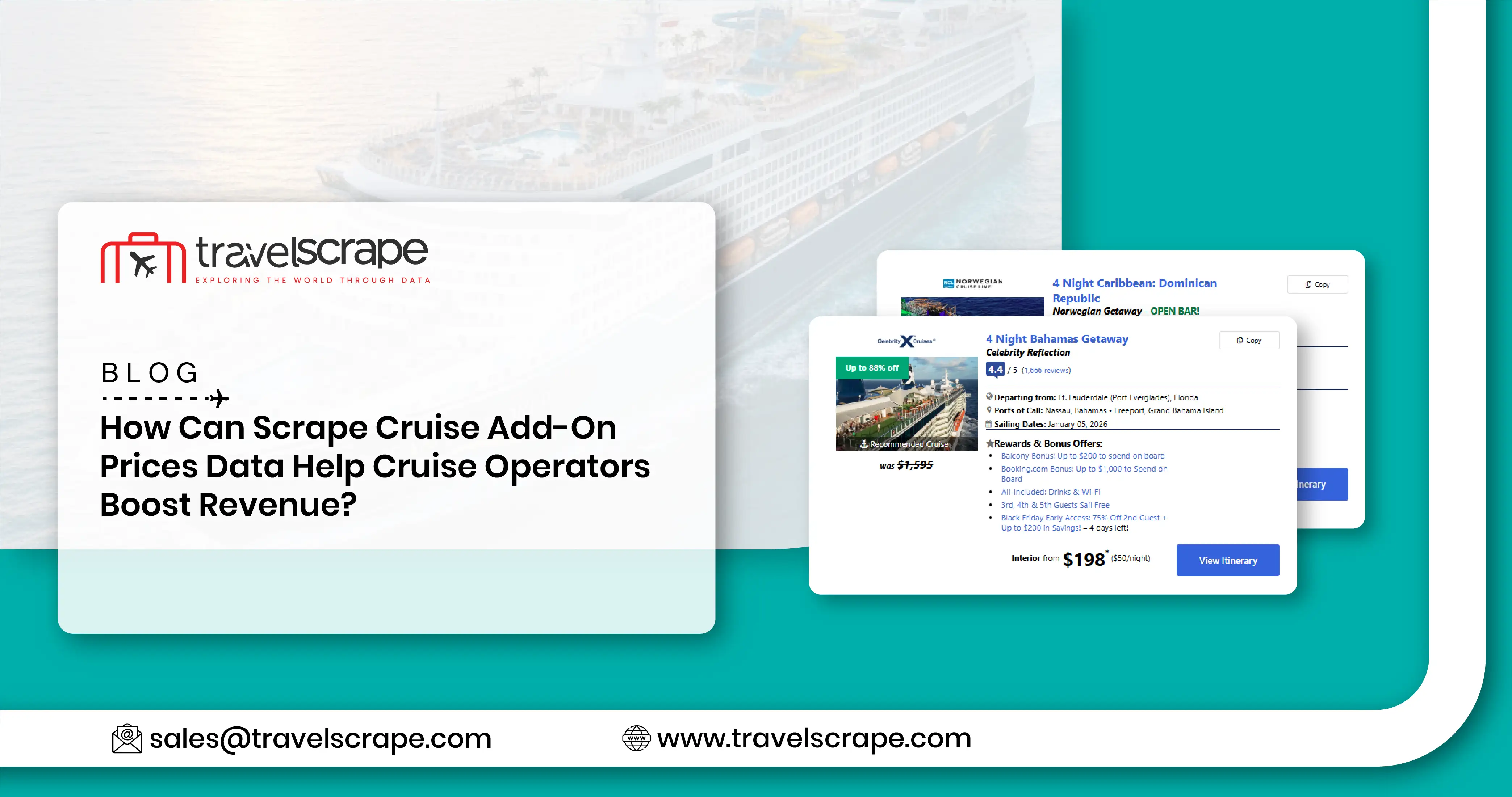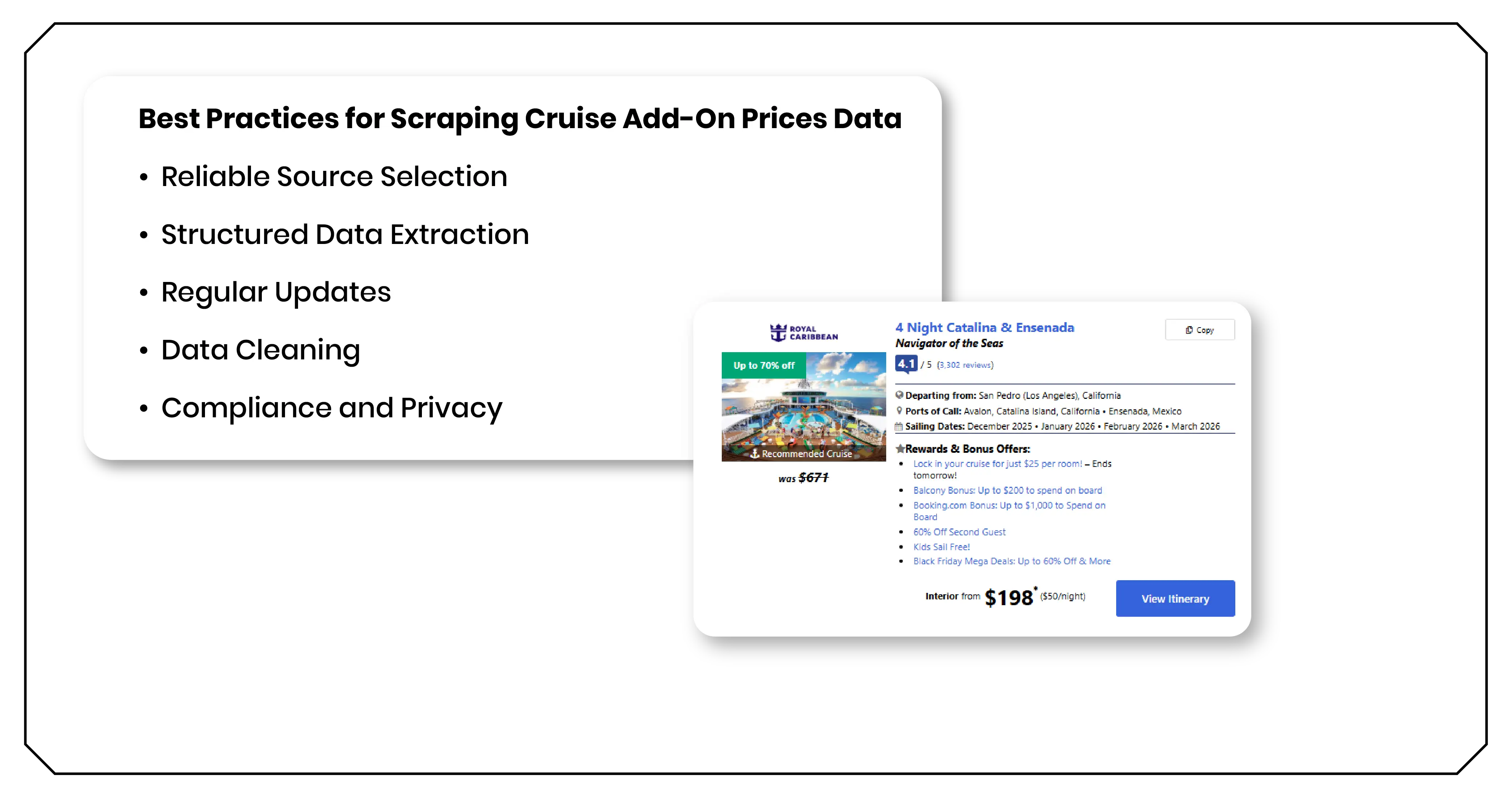How Can Scrape Cruise Add-On Prices Data Help Cruise Operators Boost Revenue?

Introduction
In the competitive cruise industry, the need to Scrape Cruise Add-On Prices Data has emerged as a critical strategy for operators and travel analysts seeking to maximize revenue streams. By gathering comprehensive data on onboard optional services such as specialty dining, shore excursions, spa packages, and entertainment upgrades, cruise lines can make informed decisions on pricing, promotions, and service offerings. Complementing this, Cruise & Ferry Data Scraping Services provide an automated and structured approach to collecting vast amounts of add-on pricing information, saving time and ensuring accuracy.
Understanding the pricing patterns and demand for optional services enables cruise operators to adjust their offerings dynamically. This ensures passengers receive tailored experiences while the cruise line achieves optimal profitability. In a market where customer preferences and booking trends shift rapidly, leveraging data intelligence from add-ons has become a competitive advantage.
The Importance of Scraping Cruise Optional Services Price

Scrape Cruise Optional Services Price dataset to help cruise lines monitor every add-on service available to passengers, from premium dining experiences to guided shore excursions. Tracking these prices across multiple cruises, ships, and routes allows operators to identify profitable services, seasonal trends, and areas where pricing adjustments could enhance revenue.
Optional services often represent a significant portion of a cruise line’s ancillary revenue. By collecting and analyzing price data, operators can refine their marketing strategies, create bundled offers, and highlight high-demand packages. Additionally, monitoring competitors’ add-on pricing provides insights that inform competitive pricing strategies.
Leveraging the Global Cruise Route Dataset
The Global Cruise Route Dataset is critical for understanding the context of add-on pricing. Different routes may have varying demand for specific services depending on port attractions, regional preferences, and seasonal factors. By integrating route data with add-on prices, cruise lines can tailor service offerings to specific itineraries, ensuring maximum revenue per passenger.
For instance, a Caribbean route may see higher demand for shore excursions, while Mediterranean cruises might generate more revenue from onboard wine tastings or specialty dining. Combining route datasets with pricing insights enables operators to optimize revenue strategies across their global itineraries.
Extracting Cruise Revenue Optimization Data
Extract Cruise Revenue Optimization Data to identify trends in passenger spending on optional services. By analyzing historical price data, booking patterns, and usage rates, companies can forecast demand, optimize pricing, and introduce dynamic promotions that maximize profitability.
Revenue optimization extends beyond individual add-on prices. Operators can segment customers based on spending behavior, cabin category, or travel frequency, then create targeted offers that encourage higher uptake of optional services. Advanced analytics on revenue data also informs strategic decisions for fleet deployment and package offerings.
Harnessing Cruise and Ferry Data Intelligence
Cruise and Ferry Data Intelligence plays a pivotal role in understanding the broader market and competitor behavior. By aggregating pricing data from multiple sources, cruise operators can benchmark against industry standards, monitor seasonal fluctuations, and evaluate emerging trends.
Data intelligence tools allow cruise companies to combine add-on prices with occupancy rates, passenger demographics, and booking patterns. This holistic view empowers operators to make informed pricing decisions, manage inventory effectively, and plan marketing campaigns that maximize ancillary revenue.
Tracking Cruise Excursion and Package Price
Cruise Excursion and Package Price Tracking is essential for monitoring the financial performance of specific add-ons. Shore excursions, onboard workshops, and premium dining packages often fluctuate in demand depending on itinerary, season, and customer segment.
Tracking excursion prices across multiple cruises enables operators to identify high-performing packages and underutilized services. Operators can then adjust pricing, create bundled offerings, or introduce promotions to boost engagement and revenue. This data-driven approach ensures that optional services are priced competitively while still maximizing profitability.
Monitoring Cruise Industry Trends
Cruise Industry Trends provide valuable context for add-on pricing strategies. Understanding evolving passenger preferences, emerging destinations, and popular onboard services helps cruise lines stay ahead of competitors.
For example, data may reveal increasing demand for wellness packages, immersive shore excursions, or specialty dining experiences. Incorporating these insights allows operators to adjust pricing and offerings proactively. Trend analysis also helps identify gaps in services where new add-on opportunities can be introduced to increase ancillary revenue.
Aggregating Cruise Line Add-On Price Data
Cruise Line Add-On Price Data Aggregation involves compiling add-on pricing from multiple cruise ships, routes, and operators into a structured dataset. Aggregation enables companies to perform comparative analysis, identify revenue patterns, and make strategic decisions across the fleet.
Aggregated data simplifies monitoring of competitor pricing, seasonal changes, and service popularity. Operators can analyze which optional services generate the highest margins and where pricing adjustments could drive additional revenue. A consolidated dataset also allows for predictive modeling of passenger behavior and spending on add-ons.
Best Practices for Scraping Cruise Add-On Prices Data

Effective method to Scrape Cruise Add-On Prices Data requires following industry best practices to ensure accuracy and compliance:
- Reliable Source Selection: Collect data from official cruise websites, booking platforms, and travel apps.
- Structured Data Extraction: Use automated tools to capture add-on names, prices, package details, and availability.
- Regular Updates: Ensure datasets reflect real-time pricing and seasonal changes to maintain relevance.
- Data Cleaning: Remove duplicates, inconsistencies, and incomplete entries to ensure data quality.
- Compliance and Privacy: Adhere to data privacy laws and platform terms to avoid legal risks.
By implementing these best practices, operators can build robust datasets that provide actionable insights for revenue optimization.
Using Analytics for Revenue Growth
Once add-on pricing data is collected, analytics tools can uncover hidden opportunities for revenue growth. Machine learning models and statistical analysis can reveal patterns in passenger behavior, seasonal demand, and high-margin services.
For example, predictive models can forecast peak demand for spa packages or excursions on specific itineraries. Operators can then adjust pricing dynamically or create bundled offers to maximize take-up. This ensures that each optional service contributes optimally to total revenue without overpricing or underutilizing resources.
How Travel Scrape Can Help You?
- Comprehensive Cruise & Travel Insights – Access structured datasets covering cruise itineraries, add-on prices, ferry routes, and passenger preferences for smarter decision-making.
- Revenue Optimization – Analyze add-on services, excursions, and onboard packages to identify high-margin opportunities and maximize profitability.
- Competitive Intelligence – Monitor competitor pricing, service offerings, and industry trends to stay ahead in the dynamic travel market.
- Automated Data Collection – Save time with advanced scraping tools that capture accurate, up-to-date information from multiple sources.
- Data-Driven Decision Support – Leverage aggregated and cleaned datasets for pricing strategies, marketing campaigns, and operational planning.
Conclusion
By leveraging Cruise onboard package price scraping, cruise lines can gain a detailed view of optional service performance, identify profitable trends, and optimize revenue streams.
Implementing Cruise Add-On Price Monitoring ensures operators track pricing fluctuations, seasonal demand, and competitor behavior efficiently.
Additionally, companies can Scrape Travel App Data for Analyze Top Cruise Booking to understand passenger preferences, booking patterns, and high-demand services. Combining these insights allows cruise operators to make data-driven decisions, create compelling packages, and enhance overall passenger satisfaction while maximizing profitability across their itineraries.
Ready to elevate your travel business with cutting-edge data insights? Scrape Aggregated Flight Fares to identify competitive rates and optimize your revenue strategies efficiently. Discover emerging opportunities with tools to Extract Travel Website Data, leveraging comprehensive data to forecast market shifts and enhance your service offerings. Real-Time Travel App Data Scraping Services helps stay ahead of competitors, gaining instant insights into bookings, promotions, and customer behavior across multiple platforms. Get in touch with Travel Scrape today to explore how our end-to-end data solutions can uncover new revenue streams, enhance your offerings, and strengthen your competitive edge in the travel market.
.webp)
.webp)